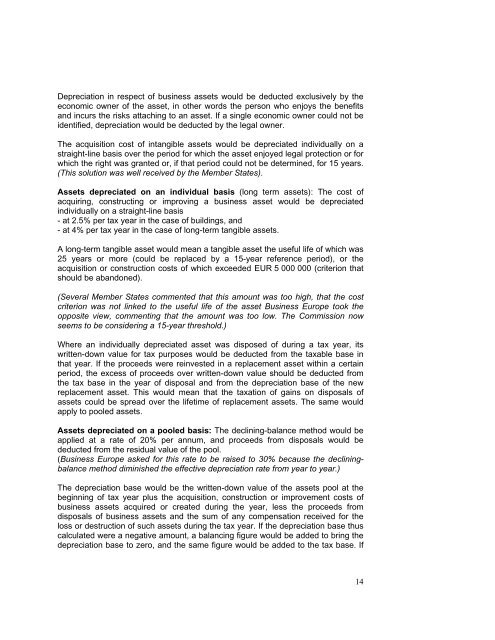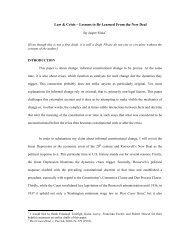An outline of the CCCTB (Common Consolidated Corporate Tax ...
An outline of the CCCTB (Common Consolidated Corporate Tax ...
An outline of the CCCTB (Common Consolidated Corporate Tax ...
Create successful ePaper yourself
Turn your PDF publications into a flip-book with our unique Google optimized e-Paper software.
Depreciation in respect <strong>of</strong> business assets would be deducted exclusively by <strong>the</strong><br />
economic owner <strong>of</strong> <strong>the</strong> asset, in o<strong>the</strong>r words <strong>the</strong> person who enjoys <strong>the</strong> benefits<br />
and incurs <strong>the</strong> risks attaching to an asset. If a single economic owner could not be<br />
identified, depreciation would be deducted by <strong>the</strong> legal owner.<br />
The acquisition cost <strong>of</strong> intangible assets would be depreciated individually on a<br />
straight-line basis over <strong>the</strong> period for which <strong>the</strong> asset enjoyed legal protection or for<br />
which <strong>the</strong> right was granted or, if that period could not be determined, for 15 years.<br />
(This solution was well received by <strong>the</strong> Member States).<br />
Assets depreciated on an individual basis (long term assets): The cost <strong>of</strong><br />
acquiring, constructing or improving a business asset would be depreciated<br />
individually on a straight-line basis<br />
- at 2.5% per tax year in <strong>the</strong> case <strong>of</strong> buildings, and<br />
- at 4% per tax year in <strong>the</strong> case <strong>of</strong> long-term tangible assets.<br />
A long-term tangible asset would mean a tangible asset <strong>the</strong> useful life <strong>of</strong> which was<br />
25 years or more (could be replaced by a 15-year reference period), or <strong>the</strong><br />
acquisition or construction costs <strong>of</strong> which exceeded EUR 5 000 000 (criterion that<br />
should be abandoned).<br />
(Several Member States commented that this amount was too high, that <strong>the</strong> cost<br />
criterion was not linked to <strong>the</strong> useful life <strong>of</strong> <strong>the</strong> asset Business Europe took <strong>the</strong><br />
opposite view, commenting that <strong>the</strong> amount was too low. The Commission now<br />
seems to be considering a 15-year threshold.)<br />
Where an individually depreciated asset was disposed <strong>of</strong> during a tax year, its<br />
written-down value for tax purposes would be deducted from <strong>the</strong> taxable base in<br />
that year. If <strong>the</strong> proceeds were reinvested in a replacement asset within a certain<br />
period, <strong>the</strong> excess <strong>of</strong> proceeds over written-down value should be deducted from<br />
<strong>the</strong> tax base in <strong>the</strong> year <strong>of</strong> disposal and from <strong>the</strong> depreciation base <strong>of</strong> <strong>the</strong> new<br />
replacement asset. This would mean that <strong>the</strong> taxation <strong>of</strong> gains on disposals <strong>of</strong><br />
assets could be spread over <strong>the</strong> lifetime <strong>of</strong> replacement assets. The same would<br />
apply to pooled assets.<br />
Assets depreciated on a pooled basis: The declining-balance method would be<br />
applied at a rate <strong>of</strong> 20% per annum, and proceeds from disposals would be<br />
deducted from <strong>the</strong> residual value <strong>of</strong> <strong>the</strong> pool.<br />
(Business Europe asked for this rate to be raised to 30% because <strong>the</strong> decliningbalance<br />
method diminished <strong>the</strong> effective depreciation rate from year to year.)<br />
The depreciation base would be <strong>the</strong> written-down value <strong>of</strong> <strong>the</strong> assets pool at <strong>the</strong><br />
beginning <strong>of</strong> tax year plus <strong>the</strong> acquisition, construction or improvement costs <strong>of</strong><br />
business assets acquired or created during <strong>the</strong> year, less <strong>the</strong> proceeds from<br />
disposals <strong>of</strong> business assets and <strong>the</strong> sum <strong>of</strong> any compensation received for <strong>the</strong><br />
loss or destruction <strong>of</strong> such assets during <strong>the</strong> tax year. If <strong>the</strong> depreciation base thus<br />
calculated were a negative amount, a balancing figure would be added to bring <strong>the</strong><br />
depreciation base to zero, and <strong>the</strong> same figure would be added to <strong>the</strong> tax base. If<br />
14
















